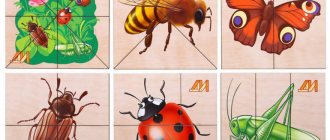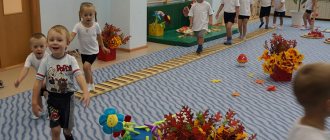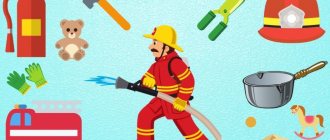Edible-inedible
The purpose of the didactic game is to teach preschoolers to distinguish between edible and inedible mushrooms. This activity requires pictures of mushrooms and a basket.
The teacher asks a riddle about a mushroom. Children guess and find the image among the pictures. If the mushroom is edible, put the picture in the basket.
Teaching ecology in a playful way arouses interest in children, develops curiosity, thinking ability and desire to understand the world around them, and broadens their horizons. Preschoolers consolidate knowledge about the world around them and gain an understanding of the relationships between natural objects and phenomena.
Didactic games on ecology for 2nd junior group
Didactic games on ecology for 2nd junior group.
1. “Where is the bunny hiding!”
Target:
describe, name plants based on their characteristic features and in connection with the environment. Write descriptive riddles and guess riddles about plants.
Rules of the game:
A plant can be named only after describing any of its characteristics one by one.
Progress of the game:
The game is played in the park, in the forest, in the square. A driver is selected from a group of children, the rest are divided into two subgroups. The driver hides the bunny under some plant (tree, bush) so that the other children do not see where the toy is hidden. Then the driver describes the plant (if it is difficult, the teacher helps). Whichever group guesses faster what plant the bunny is under, goes to look for it. For example, a toy is hidden under an oak tree. The leader asks the 1st subgroup a riddle: “This is a tree, it has a strong, mighty trunk” (Answers from the children of the 1st subgroup), to the 2nd subgroup: “The leaves of this tree turn brown in the fall” (Answers from the children of the 2nd subgroup) . Etc.
The description riddles continue until one of the subgroups guesses.
2. “Where does it grow?”
Target:
teach children to group vegetables and fruits, develop quick reaction to the teacher’s word, endurance, and discipline.
Rules of the game:
sort out the vegetables and fruits, and put some in the garden, others in the garden (imitation - pictures of a garden and vegetable garden). The team that quickly puts all the items in their places wins.
Progress of the game:
The children are divided into two teams: vegetable growers and gardeners. Vegetables and fruits (dummies can be used) are laid out on the table. At the teacher’s signal, children sort vegetables and fruits into the ones corresponding to the pictures. The team that finishes the job first wins. Children not participating in the teams check the correctness of the selection.
After this, the winning team is announced. The game continues with other teams.
3. "Our friends"
Target:
Expand children's ideas about the lifestyle of animals that live in the house (fish, birds, animals), about caring for them, about their homes, cultivate a caring attitude, interest and love for them.
Material:
lotto cards with images of animals: parrots, aquarium fish, hamsters, turtles, etc. Small cards depicting their homes (cage, terrarium, aquarium, box, etc.), food.
Progress of the game:
Lotto cards are distributed to the participants of the game; the presenter has small cards with the image turned down. The presenter takes any card and shows it to the participants. The participant who needs this card raises his hand and explains why this card is needed specifically for his animal.
To make it more difficult, you can add squats that are not related to these animals.
4. "Flower shop"
Target:
consolidate children's knowledge about plants (meadows, indoors, gardens), consolidate the ability to find the right flower according to the description. Learn to group plants by type.
Material:
you can use cards from the botanical lotto; you can take real indoor plants, but not very large ones.
Progress of the game:
The leader is selected, he is the seller (first the lead teacher, and then the child is selected according to the counting rhyme), the rest of the children are buyers. The buyer must describe the plant in such a way that the seller can immediately guess what plant he is talking about.
5. “The postman brought the parcel”
Target:
To form and expand children’s ideas about vegetables, fruits, mushrooms, etc., teach them to describe and recognize objects by description.
Material:
objects (dummies). Each is individually packaged in a paper bag. You can use riddles.
Progress of the game:
The parcel is brought to the group. The presenter (teacher) distributes parcels to each child. Children look into them and take turns telling what they received in the mail. Children are asked to describe what is in their bag using a description or a riddle.
6. “Edible – not edible”
Target:
to form and consolidate children's knowledge about vegetables and fruits and berries. Develop memory and coordination.
Material:
Ball.
Progress of the game:
The presenter names a vegetable, fruit, berry or any object, throws the ball to one of the participants, if the object is one of the given ones, then he catches it.
You can play with the whole group at once using claps (clap if the item is not one of the given ones).
7. “Wonderful bag”
Target:
To form and consolidate children’s knowledge about various natural objects (animals, vegetables, fruits, etc.). Develop fine motor skills of fingers, tactile sensations, and speech of children.
Material:
A beautifully designed bag, various toys imitating animals, real or fake vegetables and fruits.
Progress of the game:
The presenter holds a bag of objects, invites the children to come up one at a time and identify the object by touch without pulling it out, and name the characteristic features. The rest of the children must guess from its description what kind of object it is, which they have not yet seen. After this, the child pulls out an object from the bag and shows it to all the children.
8. “What comes first, what comes next?”
Target:
To form and consolidate children’s knowledge about the degree of ripeness of vegetables, fruits, the order of growth of various plants, living creatures (fish, birds, amphibians).
Material:
Cards with different order of maturity 3 – 4 – 5 cards for each item (for example: green, small tomato, brown and red), order of growth (seed, sprout, taller sprout, adult plant).
Progress of the game:
Children are given cards with different orders. At the leader’s signal, they must quickly find and line up in order with the required pictures in order.
9.Shop "Seeds"
Target:
Develop and consolidate children's knowledge about seeds of different plants. Learn to group plants by type and place of growth.
Material:
Sign "Seeds". On the counter, in different boxes with models: tree, flower, vegetable, fruit, in transparent bags, there are different seeds with a picture of this plant.
Progress of the game:
The teacher suggests opening a store selling seeds. The store will have four departments. Sellers are selected for each seed department. As the game progresses, child buyers approach the sellers and name their profession: florist, gardener, vegetable grower, forester. Then they ask to sell the seeds of the plant they described and the method of growing them (one per hole, one per furrow, “pinch”, seedlings).
10. “Everyone go home!”
Target:
To form and consolidate children’s knowledge of different plants (trees, bushes), according to the shape of their leaves (fruits, seeds). Reinforce the rules of behavior in the forest and in the park.
Material:
Dried leaves of various trees (seeds, fruits).
Progress of the game:
Before going for a walk with children, the rules of behavior in the forest (park) are reinforced. It is advisable to play the game in the fall (when there are already seeds and fruits), or in the summer (only based on the shape of the leaves). The teacher suggests going on a hike. Children are given leaves (fruits, seeds) of different plants (bushes, trees). Children are divided into groups. The teacher suggests imagining that each group has a tent under a tree or bush. Children walk through the forest (park), at the teacher’s signal “It’s raining. Everyone go home!”, the children run to their “tents”. Children compare their leaves, etc. with those that grow on the tree or bush to which they ran up.
11. “Collect mushrooms in a basket”
Target:
Develop and consolidate children's knowledge about edible and inedible mushrooms, about the place of their growth; about the rules of collecting in the forest.
Material:
Flat baskets, a model representing a forest, a flannelgraph, cards with mushrooms (edible, non-edible).
Progress of the game:
Children are given cards with mushrooms. The children’s task is to name their mushroom, describe it, where it can be found (under a birch tree, in a spruce forest, in a clearing, on a stump, etc.), what it is: edible, put in a “basket”, not edible, leave in the forest (explain Why).
12. “Which branch are the kids from?”
Target:
Develop and consolidate children's knowledge about trees, their seeds and leaves. Reinforce the rules of behavior in the forest and in the park.
Material:
Dried leaves of various trees (seeds, fruits).
Progress of the game:
Before going for a walk with children, the rules of behavior in the forest (park) are reinforced. It is advisable to play the game in the fall (when there are already seeds and fruits), or in the summer (only based on the shape of the leaves). Children walk through the forest (park), at the teacher’s signal “All children on the branches!”, Children run to their trees or bushes. Children compare their leaves, etc. with those that grow on the tree or bush to which they ran up.
13. “When does this happen?”
Target:
Clarify and consolidate children's knowledge about seasonal changes in nature and animal life in different seasons of the year.
Material:
Large lotto cards with a picture of any season. Small cards with models of signs of different seasons.
Progress of the game:
The game is played like a lotto. The presenter has small cards with the image turned down. The presenter shows a card with a model, the players say what it is and when it happens. The child explains why this card is needed specifically for him. The one who closes his card first wins. But the game continues until all participants close their cards.
14. “Guess by the description”
Target:
Develop and consolidate knowledge about the appearance of natural objects (animals, plants, fish, insects, etc.). Develop memory and speech.
Material:
Cards with various types of animals, fish, birds, insects, according to the number of participants or more.
Progress of the game:
Cards are distributed to children. Their task is to describe the object without showing it so that others can guess who is depicted on their card. You can use riddles.
15. “Let’s reap the harvest”
Target:
Develop and consolidate children's knowledge about vegetables, fruits and berries. Their place of growth (garden, vegetable garden, bed, tree, bush, in the ground, on the ground).
Material:
Baskets with models: vegetables, fruits and berries (one basket). Models of vegetables, fruits and berries, or lotto cards with vegetables and fruits.
Progress of the game:
In certain places in the group, pictures of a vegetable garden and a garden are placed, where dummies or cards are located. Children can be divided into two teams: gardeners and gardeners. At the leader’s signal, the teams collect the harvest in their basket with the model. Condition: You can only transfer one item at a time.
16. "Vegetable storage"
Target:
To develop and consolidate children’s knowledge about the external signs and characteristics of vegetables and fruits, their external signs for storage and preparation, and methods for preparing them.
Material:
Planar image of jars for pickling and compotes, barrels for sourdough, storage boxes, freezer. Sets of small cards with vegetables, fruits and berries.
Progress of the game:
Each child has a set of small cards with vegetables, fruits and berries. Divide the children into teams (depending on the number of children). Each team makes its own “preparations” from its own vegetables, fruits and berries.
Or, from the total number of small cards, teams (salt, ferment, fold for storage) choose which preparations require certain vegetables, fruits and berries.
17. "Zoo"
Target:
To form and expand children’s ideas about the nutrition of domestic and wild animals (birds, animals), to cultivate a caring attitude, interest and love for them.
Material:
cards of different animals, birds, insects, food, vegetables and fruits.
Progress of the game:
Children are encouraged to feed the animals at the zoo. The game is played like a lotto. The presenter shows cards with food and insects. The player who needs this card raises his hand and explains why this card is needed specifically for his animal or bird.






